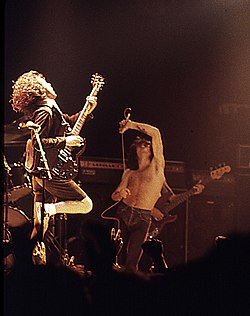Ulster Hall
The Ulster Hall is a concert hall and grade A listed building in Belfast, Northern Ireland. Situated at 34 Bedford Street in Belfast city centre, the hall hosts concerts, classical recitals, craft fairs and political party conferences. History Built in 1859 and opened in 1862,[1] the hall's purpose was to provide the expanding city of Belfast with a multi-purpose venue of sufficient size. It was designed by William J. Barre (also responsible for the Albert Clock) for the Ulster Hall Company. On its opening night on 12 May 1862, the hall was described by the local press as:
In 1902 the hall was purchased by Belfast City Council (then named the Belfast Corporation) for £13,500 and it has been used as a public hall ever since.[4] During World War II it was used as a dance hall to entertain American troops stationed in Northern Ireland.[1] Mulholland Grand OrganThe Ulster Hall features one of the oldest examples of a functioning classic English pipe organ. The Mulholland Grand Organ is named in honour of former Mayor of Belfast, Andrew Mulholland, who donated £3000 to the hall toward its cost in the 1860s.[5] It was built by William Hill & Son and donated after the hall was officially opened. In the late 1970s, the organ was extensively restored to Hill's own original design. Mullholland's great-great-grandson, Henry Mulholland, 4th Baron Dunleath, oversaw the restoration.[6] Joseph Carey's Belfast scenesIn 1902, Belfast City Council commissioned the local artist Joseph W. Carey to produce thirteen scenes from Belfast history on canvas, to be mounted within the Ulster Hall. The scenes depict the city and the surrounding area, incorporating historical and mythological influences.[3][7] The paintings were restored in 1989 and again, by Kiffy Stainer-Hutchins & Co., King's Lynn, in 2009 (see 2007–2009 refurbishment, below). Notable performancesThe hall has hosted a massive variety of acts during its history, including readings by Charles Dickens and performances by actors, pop, opera, rock acts and singers.[1][8] 
Notable political ralliesSince its opening, the Ulster Hall has staged political rallies for many different causes, most notably:
UnionismUlster Hall has a longstanding historical association with Ulster unionism and from the late 19th century became the traditional venue for high-profile unionist rallies.[11][12] Ulster Hall has been described as an "iconic venue for unionism",[12] "synonymous with unionism",[13] a "bastion of Ulster unionism",[14] and the "birthplace of Ulster unionism".[15] The Ulster Unionist Council (UUC) held its first public meeting in the Ulster Hall in 1905.[15] In early 1912 First Lord of the Admiralty Winston Churchill was invited to a rally on the subject of Irish Home Rule in Belfast at the behest of the Ulster Liberal Association.[12] The Ulster Unionist Council passed a resolution declaring the Liberals intent to hold the demonstration a "deliberate challenge" and resolved to "take steps to prevent it being held". Churchill published a letter in the press reluctantly conceding the Ulster Hall venue and after difficulties the meeting took place at Celtic Park.[12] In November 1995 Sinn Féin during the Northern Ireland peace process organised a rally in Ulster Hall; it was the first time nationalists had used the venue. Unionists on Belfast city council were outraged and threatened to try to have the booking cancelled.[15] Leader of the Democratic Unionist Party (DUP) group in the council, Sammy Wilson described the Sinn Fein event at Ulster Hall as a "deliberate attempt to rub unionists noses in the dirt".[13] 2009 refurbishmentIn 2007, a major refurbishment plan was initiated by the Consarc Design Group, under the direction of architect and Everest mountaineer Dawson Stelfox.[8] The main aim of the refurbishment was to restore the venue back to its original condition, while also modernising the building's facilities and providing better disabled access.  The £8.5 million project included:[3]
The refurbishment was performed by Graham Building Contractors and was jointly funded by Belfast City Council, the Department of Culture, Arts and Leisure, the Heritage Lottery Fund and the Arts Council of Northern Ireland. The hall was reopened with a gala event on 6 March 2009.[17] Previously stated as 1,850,[18] the seated capacity of the refurbished hall is 1,000.[2] In popular cultureThe Ulster Hall served as the eleventh "Pit Stop" during the 22nd season of The Amazing Race.[19] References
Further reading
External linksWikimedia Commons has media related to Ulster Hall, Belfast. |
||||||||||||||||||||||||||||

















